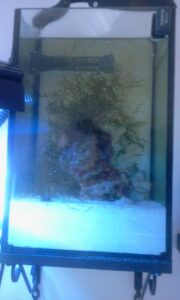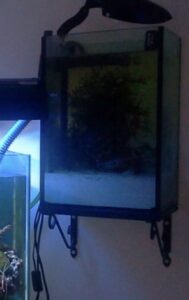Seeing this photo brought back a flood of memories and sparked my interest in sharing my experience.
In this article, I want to share my experience.
A refugium, or refuge, is a separate part of a reef marine aquarium that is used to cultivate beneficial algae, invertebrates, or helpful bacteria. This additional space can offer numerous benefits for the health of the aquarium and the stability of the system.
A refugium can be created in various ways. It is typically comprised of a separate tank or section within the main aquarium, connected by a water flow system. Water from the main aquarium is passed through the refugium, which may contain live rocks, sand, and various organisms such as macroalgae, copepods, or other beneficial invertebrates.
In my specific setup, I had a refugium connected to the main tank, positioned at an elevated level so that the overflow water would cascade back into the main tank, thereby nourishing it.
Water flow is also crucial in a refugium setup. Ideally, the water should flow from the main tank into the refugium, allowing the organisms in the refugium to filter and process the water. The water then returns to the main tank, completing the cycle. This flow ensures that the refugium receives a constant supply of nutrients and oxygen, while also preventing the buildup of detritus.
There are several reasons why one might want to incorporate a refugium in their reef marine aquarium. Firstly, the refugium can help reduce nutrient levels in the main tank by providing an environment where beneficial algae can grow and absorb excess nitrates and phosphates. This can help prevent the proliferation of unwanted algae in the main tank.
Secondly, the refugium can provide a safe habitat for helpful invertebrates like copepods or isopods, which can assist in cleaning the aquarium by feeding on detritus and unwanted algae.
Lastly, the refugium can serve as a place for the reproduction and growth of organisms that can be used as food for fish or corals in the main tank.
It is important to consider the size of your aquarium and the specific needs of its inhabitants before deciding if a refugium is suitable for your system. The size of the refugium should be proportionate to the main tank, typically around 10-20% of the total system volume. This allows for a sufficient amount of water flow and space for the organisms to thrive.
In terms of lighting, the refugium can benefit from a different light spectrum than the main tank. While the main tank may require intense lighting for the growth of corals, the refugium can thrive under lower light conditions. This can be achieved by using separate lighting fixtures or adjusting the intensity of the existing lights. In my experience I used a photoperiod inverse to that of the main tank. And I got a lot of benefits.
Incorporating a refugium in your reef marine aquarium can provide numerous benefits for the overall health and stability of the system. It can help reduce nutrient levels, provide a safe habitat for beneficial organisms, and serve as a source of food for the main tank inhabitants. However, it’s important to carefully plan and maintain the refugium to ensure its effectiveness and compatibility with your specific setup.


Please follow and like us:
